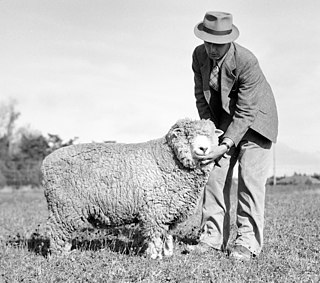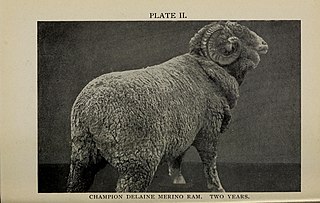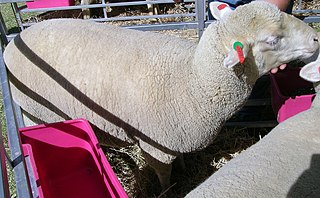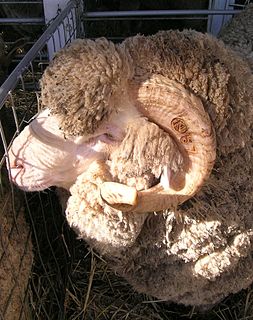See also
- Marino (disambiguation)
- Merindad, a medieval Spanish municipality run by a merino
Merino is an economically influential breed of sheep prized for its wool.
Merino may also refer to:

Wool is the textile fibre obtained from sheep and other mammals, especially goats, rabbits, and camelids. The term may also refer to inorganic materials, such as mineral wool and glass wool, that have properties similar to animal wool.

Irvington is a home rule-class city in Breckinridge County, Kentucky, in the United States. The population was 1,181 at the 2010 census.
Irvington may refer to:

Lamb, hogget, and mutton, generically sheep meat, are the meat of domestic sheep, Ovis aries. A sheep in its first year is a lamb and its meat is also lamb. The meat from sheep in their second year is hogget. Older sheep meat is mutton. Generally, "hogget" and "sheep meat" are not used by consumers outside Norway, New Zealand, South Africa, Scotland and Australia. Hogget has become more common in England, particularly in the North often in association with rare breed and organic farming.

The Merino is a breed or group of breeds of domestic sheep, characterised by very fine soft wool. It was established in Spain near the end of the Middle Ages, and was for several centuries kept as a strict Spanish monopoly; exports of the breed were not allowed, and those who tried risked the death penalty. During the eighteenth century, flocks were sent to the courts of a number of European countries, including France, Hungary, the Netherlands, Prussia, Saxony and Sweden. The Merino subsequently spread to many parts of the world, including South Africa, Australia, and New Zealand. Numerous recognised breeds, strains and variants have developed from the original type; these include, among others, the American Merino and Delaine Merino in the Americas, the Australian Merino, Booroola Merino and Peppin Merino in Oceania, the Gentile di Puglia, Merinolandschaf and Rambouillet in Europe.

The Border Leicester is a British breed of sheep. It is a polled, long-wool sheep and is considered a dual-purpose breed as it is reared both for meat and for wool. The sheep are large but docile. They have been exported to other sheep-producing regions, including Australia and the United States.

The Dorper is a South African breed of domestic sheep developed by crossing Dorset Horn and the Blackhead Persian sheep. The breed was created through the efforts of the South African Department of Agriculture to breed a meat sheep suitable to the more arid regions of the country. It is now farmed in other areas as well, and is the second most common sheep breed in South Africa.

The Romney, formerly called the Romney Marsh sheep but generally referred to by the local farmers as the Kent, is a breed of sheep originating in England. The Romney is a "long-wool" breed recognized in England by 1800. Exported to other continents, the Romney is an economically important sheep breed, especially to the sheep-meat and wool export trades of New Zealand.

The Corriedale is a New Zealand breed of sheep. It was bred from about 1882 in the South Island by James Little, who cross-bred Merino and Lincoln Longwool sheep. The breed was officially recognised in 1911. It has been exported to Australia and to many countries in Africa, Asia, Europe and North and South America. In 2021 it was reported from twenty-five countries, and the total population was estimated at just over 5 million.

The Rambouillet is a breed of sheep classified of the genus Ovis. It is also known as the Rambouillet Merino or the French Merino. The development of the Rambouillet breed started in 1786, when Louis XVI purchased over 300 Spanish Merinos from his cousin, Charles III of Spain. The flock was subsequently developed on an experimental royal farm, the Bergerie royale built during the reign of Louis XVI, at his request, on his domain of Rambouillet, 50 km southwest of Paris, which Louis XVI had purchased in December 1783 from his cousin, Louis Jean Marie de Bourbon, Duke of Penthièvre. The flock was raised exclusively at the Bergerie, with no sheep being sold for several years, well into the 19th century.

The Dorset Horn is an endangered British breed of domestic sheep. It is documented from the seventeenth century, and is highly prolific, sometimes producing two lambing seasons per year. Among British sheep, it is the only breed capable of breeding throughout the winter.

The Cormo is an Australian breed of sheep developed in Tasmania by crossing Corriedale rams with superfine Saxon Merino ewes in the early 1960s. The name Cormo is derived from the names of two of the parent breeds, Corriedale and Merino. The breed was fixed through intense selection criteria, assessed by objective measurement. Cormo sheep have a polled, open face, are possessed of a fast-growing, medium frame carrying a fleece of about 18 to 23 microns in diameter. High fertility is an attribute, too.

The Delaine Merino is a type of Merino sheep predominant in North America. It has fewer skin wrinkles than some types of Merino, but still has a fine, oily fleece that extends through the legs. They are hardy and long–lived, with an ability to thrive on the arid ranges of the Southwest United States. This breed originated in Spain, and is raised primarily for wool production.

The South African Meat Merino or SAMM is a wool and meat sheep originating in South Africa, but now found throughout the world.
The Comeback is a type of domestic sheep originating in Australia. This type of sheep results from crossbreds produced by British Longwool sheep and Merinos being mated back to Merinos. This cross is made to achieve a finer, better style of wool. Comeback style wool is also produced by Bond, Cormo and Polwarth sheep and they may prove easier to breed than Comebacks. The Comeback sheep are raised for meat and their fine wool.

The Île-de-France is a breed of sheep native to the French region of Île-de-France near Paris. It was first developed at a French veterinary college in the 1830s through crosses of Dishley Leicester and Rambouillet, and was originally known as the Dishley Merino. A breed association was formed in 1933, and it was rigorously tested early on its breeding for meat characteristics and maternal qualities.
Irvington Historic District may refer to:

The history of the domestic sheep goes back to between 11,000 and 9,000 BC, and the domestication of the wild mouflon in ancient Mesopotamia. Sheep are among the first animals to have been domesticated by humans. These sheep were primarily raised for meat, milk, and skins. Woolly sheep began to be developed around 6000 BC. They were then imported to Africa and Europe via trading.
Mount Merino, Kentucky is a town near Irvington in Breckinridge County, Kentucky.

The Australian Merino is an Australian breed or group of breeds of sheep, forming a significant part of the Merino group of breeds. Its origins lie in Merino sheep imported to Australia from South Africa in about 1796. By about 1830 there were almost two million Merinos in the country.